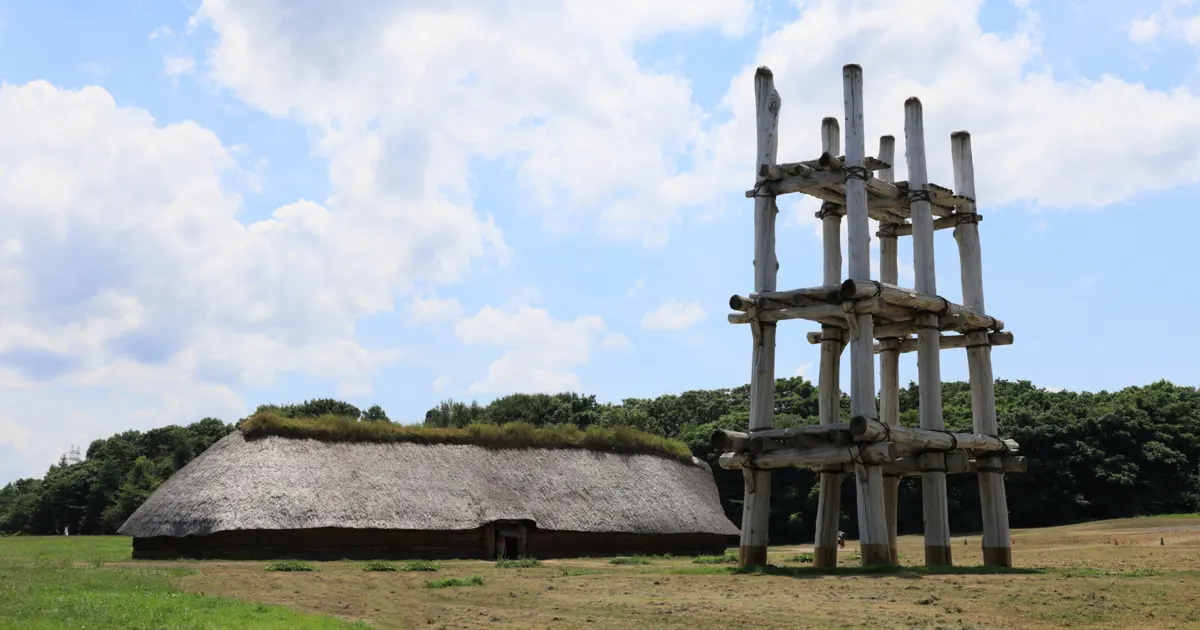Surrounded by tranquil forests, the vast Sannai-Maruyama Site offers a glimpse into ancient Jomon period life and culture . With reconstructed pit dwellings and towering pillar-supported structures, this open-air site in Aomori City invites visitors to step into ancient Japan.
This article answers common travel questions about the Sannai-Maruyama Site and shares helpful information to ensure a smooth visit. Whether you’re a first-time traveler or history enthusiast, it provides everything you need to enjoy your journey with confidence.
Why not take a moment to experience this blend of the familiar and the ancient? Discover the wonders of Sannai-Maruyama, and let us guide your next cultural adventure.
Contents
Sannai-Maruyama Access Guide for First-Time Visitors
Check the latest weather forecast before your visit: [weathernews ]
By Train
Shin-Aomori Station
From JR Shin-Aomori Station, take the Nebutan-go Bus (counterclockwise route) operated by Aomori City
Get off at “Sannai-Maruyama Iseki-mae” bus stop (approx. 15 min)
A short walk from the bus stop
Total travel time: approx. 20 minutes
Aomori Station
From JR Aomori Station, take the Nebutan-go Bus (clockwise route) operated by Aomori City
Get off at “Sannai-Maruyama Iseki-mae” bus stop (approx. 40 min)
A short walk from the bus stop
Total travel time: approx. 40 minutes
Hachinohe Station
Take the Tohoku Shinkansen to JR Shin-Aomori Station (approx. 1 hour)
Then take the Nebutan-go Bus (counterclockwise route) from Shin-Aomori Station
Get off at “Sannai-Maruyama Iseki-mae” bus stop (approx. 15 min)
A short walk from the bus stop
Total travel time: approx. 1 hour 20 minutes
One Point Advice
Sannai-Maruyama Visitor Info: Hours & Access
Admission: Free
Hours: 9:00–17:00 (until 18:00 from June to September)
Closed: December 30 – January 1
Official website: https://jomon-japan.jp/en/
Top Things to See at Sannai-Maruyama
Large Pit Dwelling|Jomon Gathering Site
Measuring over 10 meters in diameter, this massive pit dwelling reconstruction is believed to have hosted gatherings and rituals . The dug-out floor and symmetrical pillar holes are faithfully recreated, helping visitors imagine life during the Jomon era. Despite being outdoors and roofless, the layout offers clear insight into ancient Jomon construction, making history feel tangible and immersive.
Duration: 15–20 minutes
Admission: Free
Six-Pillar Structure|Jomon-Era Landmark
This symbolic structure is built upon six deep-set pillar holes, with each wooden column measuring over 1 meter in diameter and reaching over 10 meters in height. While its original function remains unclear—ranging from grain storage to watchtowers —visitors are invited to explore various theories. The sheer scale of the reconstruction impresses all who visit and showcases the ingenuity of Jomon craftsmanship.
Duration: 10–15 minutes
Admission: Free
Jomon Pouch Workshop|Hands-On Experience
Inside the site’s hands-on workshop, visitors can create their own Jomon-style pouch using plant fibers . The process—seeing, touching, and weaving—offers a hands-on learning experience that’s both fun and educational. The completed pouch can be taken home as a unique Japanese souvenir, making it a popular and memorable part of the visit. Crafting deepens the connection to daily life in the Jomon era.
Duration: 30–45 minutes
Workshop Cost: 500 yen (materials included)
Sannai-Maruyama Area: Nearby Attractions
Aomori Museum of Art|Next to Sannai-Maruyama
Just steps from the Sannai-Maruyama Site, this museum’s striking white architecture makes use of natural light to enhance its exhibits. Featuring works by artists such as Yoshitomo Nara and Shiko Munakata, the galleries offer a peaceful and thoughtful experience. After exploring ancient history, visitors can enjoy a contrasting world of contemporary art.
A-FACTORY|Apple Sweets & Bayfront Dining
About 30 minutes from the Sannai-Maruyama Site via bus and train, A-FACTORY sits along the Aomori Bay Area . This market-style facility features local Aomori sweets and craft cider made from regional apples. Its direct connection to the station and stylish atmosphere make it perfect for lunch or souvenir shopping. It’s a must-stop spot for visitors seeking design-conscious local goods.
Hirosaki Castle|Cherry Blossoms & Historic Keep
Located about one hour by train from Shin-Aomori Station, Hirosaki Castle is famed for its seasonal beauty —especially cherry blossoms in spring and vivid foliage in autumn. With its stone walls and remaining keep, the castle grounds tell stories of Japan’s Edo period. For travelers looking to shift from ancient to feudal Japan, it makes an ideal one-day side trip. Nearby teahouses and preserved samurai residences offer even more to explore.
See also this article
Top Highlights and Seasonal Tips for Visiting Hirosaki Castle
Spring in Aomori Prefecture transforms Hirosaki Castle into a dreamlike cherry blossom landscape, as the fully blooming sakura trees wrap around the stone wa…
Sannai-Maruyama Travel FAQs
What hands-on experiences are available?
You can join workshops to make Jomon-style pouches or try fire-making, offering a direct connection to ancient life.
Is it better to take a guided tour?
First-time visitors will benefit from free guided tours, which provide clear explanations that enrich the exhibits.
Is the outdoor area easy to walk around?
Yes, the site is lined with wooden walkways, making it accessible even for those wearing sandals or low heels.
Are there places to eat at the site?
A small café on-site serves light meals and menu items inspired by Jomon culture.
Are there any popular photo spots at Sannai-Maruyama?
The Six-Pillar Structure and reconstructed dwellings are great for photos, especially under natural light.
Sannai-Maruyama Summary & Next Steps
The Sannai-Maruyama Site offers a rare chance to experience Jomon-era life up close. Its reconstructed Jomon dwellings and artifacts transport visitors back thousands of years, all within a serene forest setting that calms the soul.
With easy access and multilingual support, the site welcomes even first-time travelers with ease. Through exhibitions and guided tours, you’ll gain a deeper appreciation of Japan’s prehistoric culture.
Next, why not walk over to the Aomori Museum of Art and continue your journey through Japan’s rich cultural layers?

